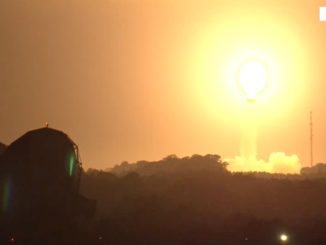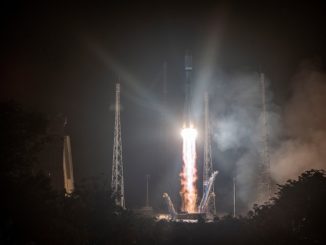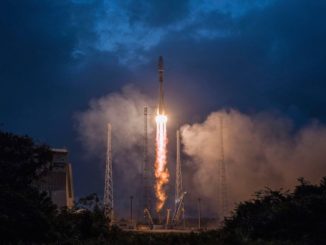
Lengthy delays for the debut of Europe’s future flagship rocket may have an end in sight. During a briefing with press on Thursday, European Space Agency Director General Josef Aschbacher announced that Ariane 6 would have its first launch between mid-June and the end of July in 2024.
The announcement comes a week after a seven-minute hot fire test of the rocket’s core stage engines in Kourou, French Guiana. The hefty delays to a launch vehicle that was originally supposed to debut in 2020 stem from a combination of “very severe” technical issues and a mismanaged schedule, according to Aschbacher.
“When I started as DG of ESA some two and a half years ago, I asked immediately for an assessment of the situation on Ariane 6 and it became crystal clear after a few months of very intense investigations that the schedule and some technical issues on Ariane 6 are not in a very good shape,” he said. “This is something that of course is highly disturbing.”
The intention was for the Ariane 6 to start flying while overlapping the Ariane 5, so that there would be a smooth transition of launch capabilities, similar to what United Launch Alliance is doing with its shift away from its Atlas 5 and Delta 4 Heavy rockets and towards Vulcan.
ESA was hit with a double whammy when its small launch vehicle, Vega C, was grounded late last year following an anomaly about 150 seconds into flight.
Aschbacher said there were two main lifelines that are helping them navigate this European launch “crisis”: working to aggressively book flights on the Ariane 6 and the Vega C through the end of the decade and kicking off a launcher challenge to spur the creation of more commercial rockets.
“This looks beyond Ariane 6 and beyond Vega C to create a new launcher of the future, which of course will only fly in the next decade,” Aschbacher said.
He pointed to the Ariane 6 Launcher Task Force, which has also helped in steering the ship towards getting the rocket on track towards a summer 2024 launch.
Ariane 6’s path to summer 2024 launch
One of the biggest milestones before the Ariane 6 maiden launch was the hot fire test, which happened on Nov. 23 and was designed to cover “the entire core stage flight phase,” according to the latest task force summary.
While the burn of the Vulcain 2.1 engine didn’t last the full, advertised 470 seconds, Toni Tolker-Nielsen, the director of space transportation at ESA, said that they were still able to achieve all of their test objectives.

With that in the rearview mirror, there are two more key milestones on the agenda for the remainder of 2023. The first is targeting Dec. 7 and will be a hot fire test of the Ariane 6’s upper stage engine and the second is the combined test loading (CTLO3) on Dec. 15. That second test, essentially a wet dress rehearsal, will conclude with a short engine burn.
Assuming both are successful, the ship carrying the components of the Ariane 6 will depart Europe near the end of January or the beginning of February, arriving in French Guiana near the end of February. Following assembly, the rocket would arrive at the launch pad by the end of April.
Martin Sion, the CEO of AiraneGroup, said if that all goes well, the test campaign would take place in May and the start of June, leading to the earliest possible launch date of June 15.
Aschbacher said that date is their ideal target, but they built in “risk margin” through the end of July on the off-chance that not everything goes to plan. He said they expect to be able to narrow down the date around the March or April timeframe.
“This is a very complex undertaking to bring a launcher to the launchpad. Literally, it is rocket science that is here at stake and therefore, it is to be expected that there may be one or another delay that can occur,” Aschbacher said. “We will continue our task force meetings towards the maiden flight and as soon as we can narrow that down as we progress… we will be in a good position to fix a date or maybe its a date plus or minus a few days of margin.”
The first mission’s payloads were announced more than a year ago, but the list was updated to include a CubeSat from NASA’s CubeSat Launch Initiative (CSLI). The ELaNa 48 (Education Launch of Nanosatellites) mission includes the CURIE (3U) CubeSat.
The CubeSat Radio Interferometry Experiment from University of California at Berkely will be among those hitching a ride on this first flight.
Future outlook
Assuming everything can stay completely or mostly on track and a successful summer launch is completed, Stéphane Israël, the CEO of Arianespace, said they are targeting a commercial launch by the end of 2024.
“We will do as many flights as possible in 2025 and we will benefit from the return on experience of the two flights of 2024,” Israël said. “And you know that on a steady basis, Ariane 6 would go to nine to ten flights per year.”
Several customers are eager to see the Ariane 6 start flying at a regular clip. Amazon is among those relying on the rocket to start getting a reliable cadence going, since it purchased 18 launches to deploy its Project Kuiper broadband internet satellites.
“For years and years, Arianespace has been dedicated on the commercial to the GTO (geostationary orbit) market… and now more and more, we will work for low Earth orbit constellations,” Israël said. “And the good here, and I really want to insist on that, is the fact that Ariane 6 is perfectly adapted to this shift in the market.”
The countdown to last week's #Ariane6 hot-fire test started 24 hours before engine ignition, for seven minutes of fire. 🔥
☁
This #timelapse condenses operations @EuropeSpacePort into just 2 minutes 🤩
☁
We will be broadcasting next steps for Europe's rocket on #ESAWebTV today… pic.twitter.com/MlyxUtRxBB— ESA Space Transport (@ESA_transport) November 30, 2023



